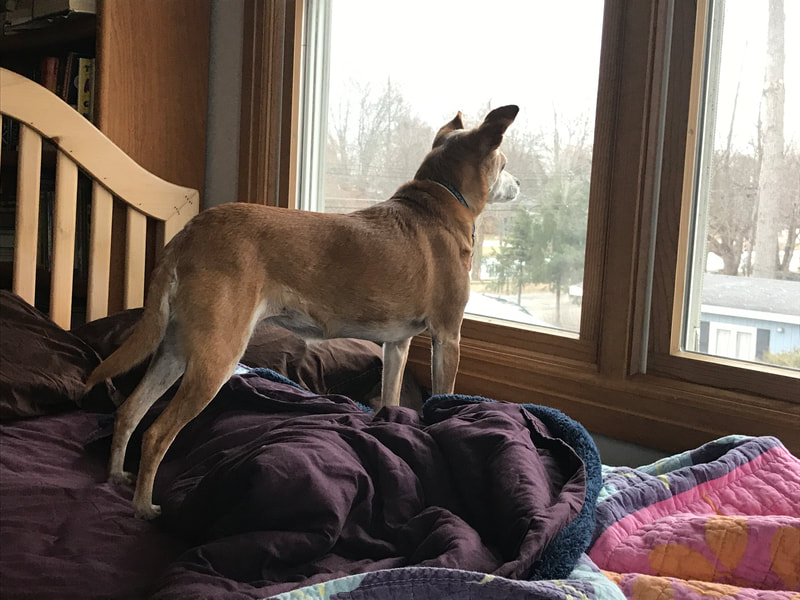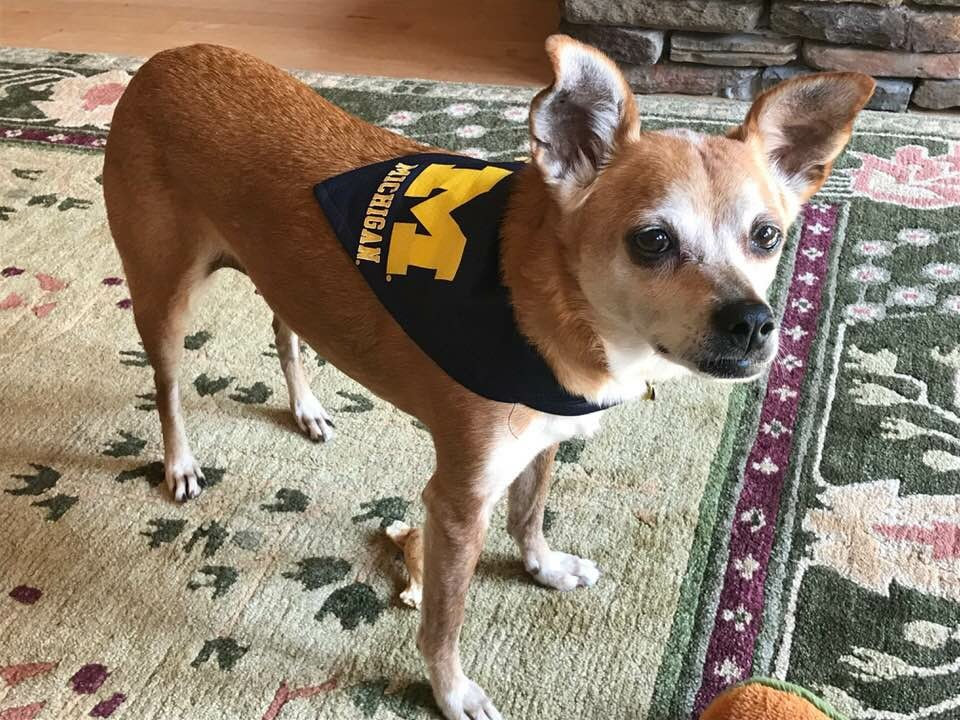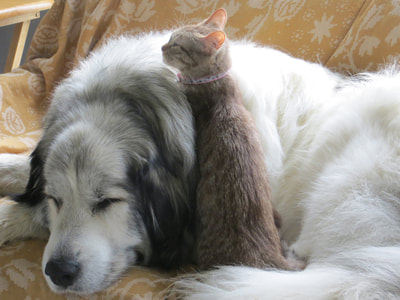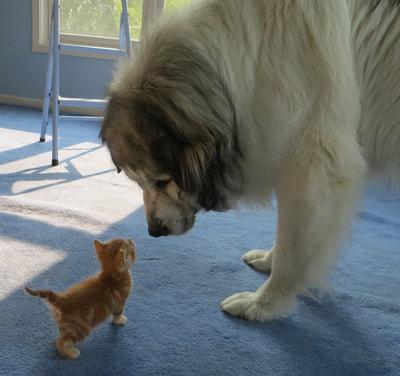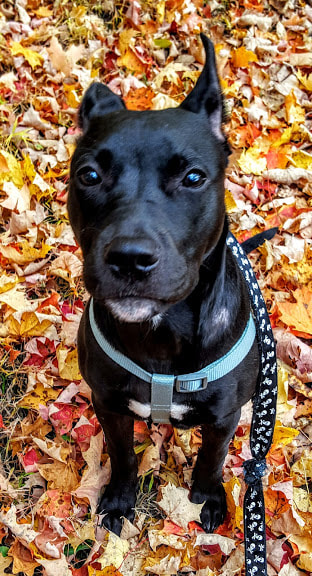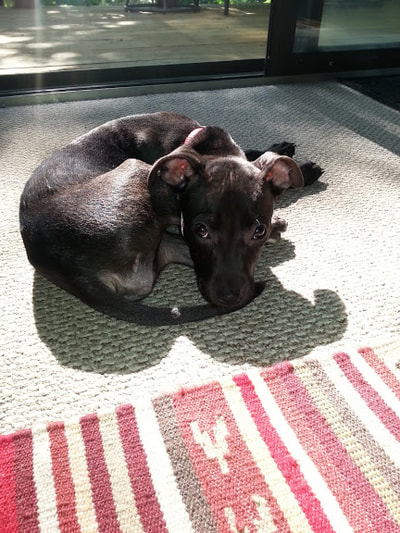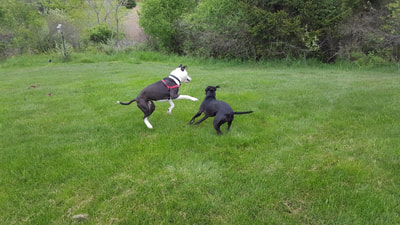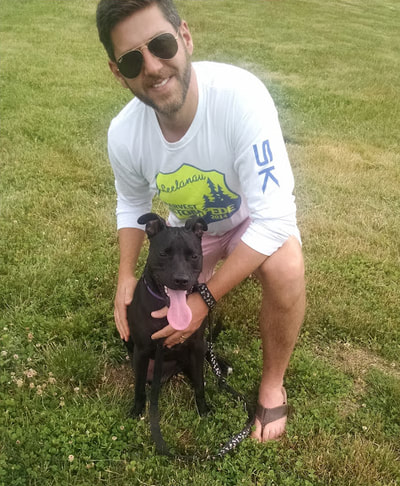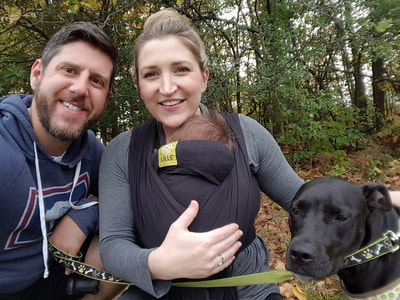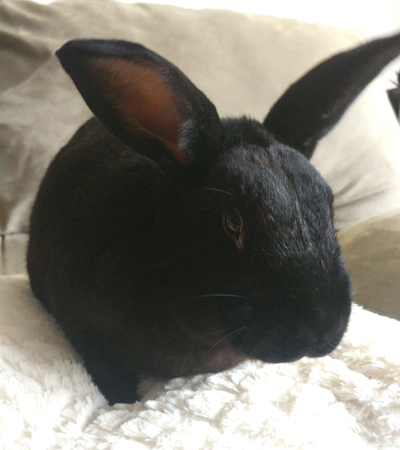GeordiHappy Valentine’s Day, everyone! We have an especially sweet treat for you this month. Allow us to introduce you to Geordi, our February Pet of the Month. He was adopted from Motor City Ferrets, along with his snuggle-buddy, Bev, (who is a sweetie in her own right) by Beth and Tony. Geordi and Bev had been at Motor City Ferrets for about a year when Beth and Tony found out the two older ferrets were currently the longest the residents at the shelter. Tony and Beth already had three ferrets at home and weren’t planning to add more, but Beth couldn’t stop thinking about the two ferrets and eventually emailed the shelter to adopt them. Both Geordi and Bev adapted quickly and took very well to their other ferrets: Socks, Deka, and Neuf. Geordi is an easy-going ferret, but also likes to be on-the-go from the minute he wakes up. Unlike most ferrets (who love the “snooze button” according to Beth), he will snap wide awake and is ready to go as soon as his sleep is disturbed. Right away, they realized he has limited or no vision, but it wasn't noted when they adopted him because it happened while he was at the shelter and he had learned the layout of the room. He has now become familiar with his new home and gets around as well as the other ferrets. He will also use his other senses which can make it difficult to get a good photo because as soon as he senses Beth or Tony nearby, he comes right over to see what they are doing. It also doesn’t stop him from playing hide-and-seek with his soft rattle toys and exploring his crinkly play tunnel. Geordi was diagnosed with insulinoma during his stay at the shelter and he was started on prednisone, a steroid. Insulinoma is a tumor on the pancreas which causes an increased secretion of insulin and is very common in middle- and old-age ferrets. The increase of insulin leads to low blood sugar which usually starts with weakness in the rear legs. If left untreated, it causes the ferret to become depressed and unresponsive during an episode. Geordi first came to City Pets because Beth noticed he was walking stiffly at times and wanted to have his glucose checked to make sure the prednisone was helping control his insulin levels. After making an adjustment to his dose based on his glucose levels, Geordi has been managing his insulinoma well. Insulinoma can sometimes be managed with surgery, but it can be an issue of cost, effectiveness, and age-related risk. We think it’s easy to see why Geordi’s story is perfect for the February Pet of the Month. It’s a heart-warming “tail” perfect for the holiday of love AND to combat the lasting effects of the polar vortex. You can visit Motor City Ferrets at http://motorcityferrets.org/ if you are interested in adopting a ferret.
0 Comments
LornaJanuary being the first month of the year inspired us to pick a dog taking her first trip overseas for Pet of the Month. A common New Year’s resolution is to travel more and Lorna, our January Pet of the Month, is starting right out of the gate in 2019. She’ll be traveling to France to visit one of her owners, Orion.
In July of 2017, Lorna joined Marika and Orion’s family after they found her at the Humane Society of Huron Valley while looking for a furry family member. They knew the second they saw the alert, curious, calm, extremely sweet Chihuahua mix she would be a great addition to their family. She is eager to meet anyone and everyone, and having met her, we can confirm this! She becomes so excited she’ll wiggle her entire body as she madly wags her tail. During her walks, she’s either trying to meet everyone she can or attempting to catch any small critters she comes across. She has achieved “Expert-level” in snake catching, sometimes diving head first into a pile of leaves and emerging with a snake, much to the chagrin of people around her. When she isn’t using her lightning speed, she loves lounging wherever her humans are just keeping an eye on them. Lorna came to City Pets in preparation for her travels with Marika to visit Orion in Annecy, France, after he took a physics post-doctorate research position overseas. To help ensure everything is in order, we recommended coming in for an initial appointment as soon as possible because of the many requirements for international travel. Traveling to some destinations can involve even more testing, including Rabies titer testing, which can take 6-8 weeks for results. There may also be a waiting period of 3-9 months required before travel. Lorna will need one more exam within ten days of travel, a specific EU Health Certificate, and an USDA-endorsed International Health Certificate, which requires an appointment with the USDA in Lansing. After her exam and the appointment at the USDA, Lorna will be able to travel with Marika to see Orion in France. According to Marika, she is quite the adventurer and has loved the road trips she’s taken with her owners but is particularly excited to visit a whole new country! If you are planning to travel with your pet, please call so we can help prepare a general timeline to get them travel-ready! You can also go to the USDA website below to get started. https://www.aphis.usda.gov/aphis/pet-travel BrewskiWe are excited to kick off summer with our June Pet of the Month, Brewski! We think he’s a rock-solid choice and we’re sure you’ll agree after reading his story. The almost three-year-old Chesapeake Bay Retriever joined Michael and Kat’s family in October of 2015. They had no idea at the time he would break one-hundred pounds. He still thinks of himself as a lap dog; a really, really big lap dog. Aside from laps, Brewski loves the people attached to those laps. He also loves food-all the food-but especially cauliflower. One of this active and energetic dog’s favorite things is water. Swimming, hoses, sprinklers, if there’s water, Brewski’s drawn to it. Normally, he sticks to warmer days, logging ten-plus hour days swimming, diving for rocks, and chasing ducks, but he once went swimming on a 37 degree January day in 2017. Despite his imperviousness to cold, Brewski is sensitive to people and notices changes around the house. The biggest change was the addition of Bianca, Kat and Michael’s newborn daughter. Brewski has taken to her and is very affectionate and caring towards his human sister. Since she’s come home, he has been looking out for her, especially when squirrels get in the backyard. Brewski does not like squirrels in the backyard. Recently, Kat brought Brewski to see us because he was not feeling like himself. He had vomited twice in 12 hours, was very lethargic, and not interested in food. This was very concerning because, as we mentioned earlier, he loves all food. During his exam, Dr. Weinrick became very concerned about a foreign body in his GI tract so we took two radiographs of his abdomen. Upon examination of the radiographs, she found a very peculiar and troubling object in his intestines. The next step was to do a barium series to ensure the object was in the intestines and to determine if anything was able to move around it. After we gave him the barium, he vomited it up within 30 minutes. This was not a good sign, but he was stable, so we set up a foreign body surgery for the next day and sent him home to rest with instructions to get him to an emergency hospital if his condition worsened before his surgery. The next morning, Dr. Weinrick wanted one more radiograph before surgery to see if the object had moved. As we watched the image develop on the screen, we were all surprised to see the object was gone. Kat had reported he was feeling a little better that morning and had tried to pass stool the night before, but wasn’t able to produce anything. With his improved demeanor and apparent desire to eat, we fed him a small amount of bland prescription food and monitored him closely. When he kept it down and basically begged for more, we may have sent up a little cheer. After Dr. Weinrick relayed the great news to Michael and Kat, they sent us an email a short while later with a photo attachment. Turns out, Brewski did have a bowel movement the night before and they were able to find the offending foreign body. He had swallowed a rock. A rock! He continued to keep food down the rest of the morning and went home without needing surgery. It was the best result for one of the best dogs. That’s why we think Brewski is a rock-solid choice for Pet of the Month. HarleyOur May Pet of the Month is a living embodiment of the classic literary institution of a “gentle giant”. Please sit back and allow us to tell you a story about Harley, the Great Pyrenees.
Harley was adopted in 2013 from the Michigan Great Pyrenees Rescue. When his new parents, Anne and Bruce attempted to load him into their SUV, he refused to jump into the back. It took both of them to lift his 115-pound frame into the vehicle. Harley has since been taught to put his front feet on the back and one of them can lift the rest of him. Anne and Bruce chose a Great Pyrenees because they are known for being friendly to small animals and it is because of this trait we have deemed him a “gentle giant”. Bruce and Anne have provided photographic evidence of his gentle demeanor as he interacts with the family’s six cats, one rabbit, and their foster kittens. They were also warned Great Pyrenees have a tendency to wander. Despite their fenced yard, they have found Harley likes to “walkabout” their rural neighborhood. His first stop is the muddy wetland and burrs behind their house and then off to check out a nearby pond and surrounding fields. Eventually, after an hour or so, he makes his way to the front porch to be lured inside with a treat. As a large breed, Harley was at a greater risk for hip and mobility issues. In December 2017, Anne noticed he was moving more stiffly and seemed to be uncomfortable when she was petting him. After a thorough exam and discussion, Dr. Weinrick sent Harley home with medications to help with inflammation and pain. It appeared to work and he was doing well until March of this year. He was again having mobility issues. This time Dr. Weinrick recommended a long-term course. After baseline blood work, he was put onto the lowest effective dose of carprofen and has been able to resume his neighborhood “walkabout”. Harley continues to enjoy his furry roommates, the snow, and lying in his favorite spot, on the sofa, snoring. His discomfort and stiffness appear to be controlled on carprofen and joint supplements. He still refuses to jump into the back of Bruce and Anne’s Escape and they definitely weren’t able to help with his distaste for temperatures over 70 degrees. All things considered, though, we think this is a story that warrants a storybook ending: “And they lived happily ever after.” RuthieIt is April, so it’s time to announce our next Pet of the Month! Our pet of the month is very appropriate because this time of year was particularly hard before her allergies were controlled. It is with great honor we announce Ruthie as our Pet of the Month!
Ruthie was named after Supreme Court Justice Ruth Bader Ginsberg because of her black coat and dash of white down her throat when she was adopted in the summer of 2015. The newlyweds, Nate and Caitlin, were on the hunt for the perfect dog to add to their growing family. As a teacher, Nate had summers off and he spent every day at the Humane Society of Huron Valley walking dogs, looking for a match. During one of his visits, he met a tiny black furball who had recently arrived from Ohio. He picked up the very sick, 8 week old puppy and knew immediately she was the one when she snuggled right up in his arms. Nate and Caitlin report she has "been a love bug ever since!" Ruthie first came to City Pets Vet Clinic in 2016 because she was experiencing one of her worst allergic reactions Caitlin and Nate had ever seen. Ruthie had suffered from allergies since she was a puppy but this time her fur was patchy and Benadryl was no longer helping. After her exam, Dr. Hui recommended Apoquel and steroids to get the symptoms under control and antibiotics to treat a skin infection. The medications helped to suppress her symptoms and she started to feel better but as soon as the course of medication ended, the scratching started again. It was time to try a diet trial and they were all in. Nate and Caitlin switched her food to a limited ingredient diet and eliminated all other foods. They began to see changes but Ruthie would still have flare ups when the seasons changed. At this point, Dr. Weinrick was concerned about seasonal allergies on top of her food allergies. Ruthie was given a cytopoint injection and now both of allergies appear to be under control with only an occasional flare up. With her allergies managed by her new diet and the diligence of her pet parents, Ruthie is able to chase frisbees, cuddle, and play with her friends at Lucky Puppy and City Pets without itching all the time. Ruthie is obsessed with her Grandma and as of September is the best big sister to the family's new (human) addition. Nate and Caitlin's only real complaint is how hard it is to capture her toothy smile and wiggly butt on camera. Smokey After a long hiatus, Pet of the Month has returned with an old dog full of new tricks. Allow us to introduce you to March’s Pet of the Month: Smokey An!
Smokey is a very sweet, 14 year-old miniature pinscher mix. He experienced his own version of a Christmas miracle when his new family decided to adopt him last year in early December. At the time of his adoption, he had untreated diabetes and mature cataracts rendering him almost completely blind. Oh, did we mention he is the An family’s first dog? Despite his disabilities, he still enjoys long walks-his current record is four miles-around his neighborhood. He also doesn’t allow them to impede him from hopping onto the sofa to nap or “looking” out of the car window. It seems he has become a creature of comfort in his new home as he loves warm baths, ripping the stuffing out of toys, and what his family calls the snack lifestyle, while despising the rain, peanut butter, and bananas. And like any senior, he loves to bark at the neighborhood kids, probably to get off his lawn. Smokey is a senior adoption success story and while he doesn’t appear to be an ideal first dog, he and the An family see things a bit differently. GeorgeWe've been anxious to introduce you to our June Pet of the Month, George! When Deb and Steve went to the Humane Society of Huron Valley, after much urging by their grandchildren, they weren't looking for a puppy nor a hound, but a 12 week-old, 14 lb Treeing Walker Coonhound named George stole their hearts. George was sweet, playful, and kid-friendly at home, it wasn't until the family's first puppy obedience class they realized "there was something a little different about George." As the family grew more excited to "start the lessons where all the secrets to having a well-behaved dog would be revealed," they had no idea what trials awaited them. Upon seeing the other dogs in the class, George became over-excited (though according to Deb and Steve, this may be a gross understatement) and became hyper-focused. He continued to bark at the other dogs, while they tried every treat or trick they could to distract him. While Steve and Deb waved cheese and hot dogs in front of him, he strained against his leash to play with his classmates. Recall seemed impossible because while his classmates would return to their owners, George "pin-balled" from classmate to classmate, ignoring his owners' increasingly embarrassed calls. There was little else they could do, but leave the class after four brutal sessions. At 6-months old, George was relentless to gain access to other dogs and critters when he spotted them. He would howl, bark, and jump, whatever was necessary to reach them. His obsessive nature eventually led to his tail becoming a focal point for his stimulation. As his focus intensified, any kind of anxiety or excitement would set George to chasing his tail. With each rotation, he would bark and this could go on for long periods every day. George seemed miserable and his owners can't even describe the agony of watching the puppy that stole their hearts suffer with his obsessive behavior. In November of 2014, Deb brought George to see Dr. Hui. While medical and physical causes were being ruled out, George began to circle in the exam room. It appeared it was behavioral and he was started on a medication to help control his anxiety. As is the case with many anti-anxiety medications, it took some time to get a good idea if it was helping and, unfortunately, for George the first medication wasn't helping much. After many conversations and a brief weaning period, George started on Prozac. After a few weeks, it appeared to be working well enough to help him start training, a key part, along with exercise, to controlling his anxiety and obsessive nature. Deb and Steve found a private trainer to help identify when the spinning was about to start and how to get his attention. They began to work with a different trainer to help with leash walking and intermittent spinning. Deb and Steve adjusted and "learned to put George on a leash indoors when he was anxious, give him clear direction when he seems uncertain, and make sure he gets plenty of exercise." George was nearly two years old and was eating better, he knew several commands, and was more manageable. George's experience is not unique when it comes to anxiety in pets. It can take weeks, sometimes months, to find the right combination of medication, training, and exercise to alleviate enough anxiety for a pet to become comfortable. Behavioral cues can exhibit in many ways, if you have concerns, please contact the clinic. George's story highlights another important aspect of raising a healthy dog: puppy classes. They can reveal early warning signals if your pup has anxieties about other dogs or people. If nothing else, they offer an opportunity to form positive associations with meeting strangers and new experiences. A year later, George still hasn't lost his intensity, but Deb, Steve, and George's persistence has paid off. He is much more relaxed and confident, even winning a few photo contests with his "movie-star" good looks and improved obedience. He takes all the attention in stride and is just like any other dog now: "show him a bike trail, bunny tail, or plump pillow at the end of the day, and he's the happiest of dogs." ClayWe're hoping you'll take a minute to meet our May Pet of the Month, Clay, as we're sure you'll see, he's definitely worth a look! Clay had done a lot of traveling in his relatively short life, before he came to City Pets Vet Clinic in September of 2016. He was born in Kentucky or Indiana, then adopted in Florida when he was 3 months old. His owners, Robert and Bethany, were walking passed a pet store when they saw his wrinkly little face. He looked so sad, they had to see him out of the cage and he never went back in. They later learned, unfortunately as is often the case, the pet store was notorious for selling very sick and poorly bred dogs. Three days after getting home, Bethany noticed Clay was lethargic and barely able to breath. They immediately took him to the emergency veterinary hospital where he was treated for severe bacterial pneumonia and a temperature of 105.8! He spent three nights in the hospital, but he recovered. Many Chinese Shar-Peis suffer from over-breeding, which can result in numerous issues including hot spots , corneal ulcerations, and irritation caused by their signature wrinkles. Clay dealt with all of these issues at one time or another. In fact, it was his corneal ulcerations and irritation that first brought Clay to City Pets Vet Clinic. The wrinkles on his face caused both his upper and lower eyelids to roll inward, which brought his eyelashes and the hair on his eyelids in direct contact with his eyes. This direct contact caused constant irritation and discomfort. Dr. Hui first saw Clay after he had an ulcer debrided at another clinic to check his progress. While this bought him some relief for a period, the irritation and discomfort returned by February. It was at this time Dr. Weinrick suggested surgical intervention to trim back the upper and lower eyelids to prevent them from rubbing on his eyes. The difference was immediate after the surgery and only became more noticeable as his swelling went down. Despite all Clay has been through, Robert and Bethany noted that none of it ever dampened his puppy-like nature. He remained playful and energetic. Every night before bed, Clay experiences something his owners have dubbed "a madness" where he sprints at top-speed from room to room, jumping on them, spinning around, and flying off to another room. Once he settles, he gets his bedtime snack and culminates with "puppy kisses" for both his people. He also has many names at home including Pickles, Pip, Smoosh, Polar Bear, and more. He responds to all of them. It also appears Clay is deathly afraid of drinks. Robert and Bethany don't know why, but if you extend a drink towards him, he hightails it into the other room. At least after his surgery, he'll see those scary drinks coming his way much better. StravosFebruary’s Pet of the Month, Stravos Antonova, is perfect because his story is one of true love. When Maria and Steven wanted to find a companion for their mini-lop, Zoe, they found themselves at Midwest Rabbit Rescue, a no-euthanasia shelter. They had concerns about finding a match because Zoe could be a little aggressive and short-tempered at times. The first few rounds of bunny speed dating didn’t do much to ease their fears. Zoe beat up each of the male suitors despite their bigger size, until she met Stravos. She was curious and though she put him in his place, she wasn’t aggressive. Our young Romeo didn’t fight her or run away; he just bowed his head and used his sweet personality and charm to win her over. Maria and Steven tried a few more Casanovas, but none could charm Zoe like Stravos did. They followed their heart and took him home the next night. Within days, Zoe was cuddling and grooming him. Their owners credit Stravos with turning their crazy bunny into a little sweetheart.
Stravos has been settling in comfortably with his new family and has already learned a few very important things. He’s already learned where the refrigerator is and also the most important sound a bunny can learn: the sound of the fridge door opening. As soon as he hears the door open, he zooms straight to the bottom drawer and grabs a whole head of lettuce-his favorite treat (see picture). Unfortunately for him, a head of lettuce is just a bit too big and he doesn’t get too far. The final thing he’s learned is if you run in front of your people and they trip over you, it leads to treats and cuddles, something his owners report he uses to his full advantage. How could we not pick Stravos as our February Pet of the Month? His story is one of second chances and a handsome charmer. Soul-mates and lettuce. Family and refrigerators. But, most importantly, it’s a story of love. This story of love was made possible by Midwest Rabbit Rescue. If you are interested in adopting a new rabbit companion, please visit their website: www.rabbitrr.org ArchieAH AH AH Choooo....Darn those allergies. September brings those nasty seasonal allergies but we're here to cheer you up with our Pet of the Month! September's featured pet is Archie, a cute 4 1/2 year old Cairn Terrier. He lives with Brooke, Shawn, Lily, and Chloe Gates; you can thank Chloe for helping keep our clinic nice and clean. She recently left us to pursue her studies and while we miss her greatly, we still get to see her and Archie occasionally. At an adorable 8 weeks old, Archie was a Christmas present from Shawn to Brooke. Brooke had a Cairn Terrier growing up and always wanted another. What a wonderful gift! Archie now has a little Yorkie sister named Maude. Like most big brothers, he both tolerates and loves her. Archie loves to sleep in late, ride in the car (his favorite!), take walks, and hang out with his favorite toy, his "santa" pillow. He can't fall asleep at night without his santa pillow; he falls asleep with it in his mouth and will walk around and whine until he finds it. Archie must be having a tough time this week because he hates wet grass and refuses to go outside in the rain. We first met Archie in 2014 and he's been coming to see us regularly ever since. Those awful allergies not only attack me but poor Archie too. The skin allergies started when he was about 2 years old, started seasonally but then continued all year. He was miserable, scratching his whole body and causing infections. His owners tried everything – food changes, oatmeal baths, food supplements, coconut oil, olive oil, antibiotics, and steroids. We could clear up the infections but the allergies continued. They finally did allergy testing at MSU and discovered an allergy to mites. Archie now gets bleach baths (following strict dilution instructions from MSU) and is on an allergy medication, Apoquel. Within a couple of days the itching was gone! It’s been just over a month now and his skin is looking great and he is so much happier. We’re so happy for Archie. Hopefully the rain will stop soon and he can enjoy going outside again, allergy free! |
Archives
April 2021
Categories |


